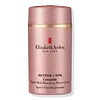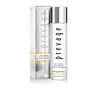What's inside
What's inside
 Key Ingredients
Key Ingredients

 Benefits
Benefits

 Concerns
Concerns

 Ingredients Side-by-side
Ingredients Side-by-side

Water
Skin ConditioningCaprylic/Capric Triglyceride
MaskingGlycerin
HumectantDiisopropyl Adipate
EmollientPentylene Glycol
Skin ConditioningDimethicone
EmollientButylene Glycol
Humectant4-T-Butylcyclohexanol
Masking1,2-Hexanediol
Skin ConditioningAcetyl Tetrapeptide-11
Skin ConditioningAcetyl Tetrapeptide-9
Skin ConditioningAmmonium Acryloyldimethyltaurate/Beheneth-25 Methacrylate Crosspolymer
Emulsion StabilisingBisabolol
MaskingButyrospermum Parkii Butter
Skin ConditioningC13-14 Isoparaffin
EmollientCaprylhydroxamic Acid
Carbomer
Emulsion StabilisingCeramide NP
Skin ConditioningCetearyl Dimethicone Crosspolymer
Dimethyl Isosorbide
SolventDisodium EDTA
Glyceryl Stearate
EmollientGlycine Soja Oil
EmollientHydroxypinacolone Retinoate
Skin ConditioningLaureth-7
EmulsifyingLimnanthes Alba Seed Oil
Skin ConditioningMacadamia Integrifolia Seed Oil
Skin ConditioningMica
Cosmetic ColorantMoringa Oleifera Seed Oil
EmollientPEG-100 Stearate
Phytosphingosine
Skin ConditioningPolyacrylamide
Polysorbate 20
EmulsifyingRetinol
Skin ConditioningSodium Hyaluronate
HumectantTromethamine
BufferingZingiber Officinale Root Extract
MaskingParfum
MaskingTocopherol
AntioxidantCI 77491
Cosmetic ColorantWater, Caprylic/Capric Triglyceride, Glycerin, Diisopropyl Adipate, Pentylene Glycol, Dimethicone, Butylene Glycol, 4-T-Butylcyclohexanol, 1,2-Hexanediol, Acetyl Tetrapeptide-11, Acetyl Tetrapeptide-9, Ammonium Acryloyldimethyltaurate/Beheneth-25 Methacrylate Crosspolymer, Bisabolol, Butyrospermum Parkii Butter, C13-14 Isoparaffin, Caprylhydroxamic Acid, Carbomer, Ceramide NP, Cetearyl Dimethicone Crosspolymer, Dimethyl Isosorbide, Disodium EDTA, Glyceryl Stearate, Glycine Soja Oil, Hydroxypinacolone Retinoate, Laureth-7, Limnanthes Alba Seed Oil, Macadamia Integrifolia Seed Oil, Mica, Moringa Oleifera Seed Oil, PEG-100 Stearate, Phytosphingosine, Polyacrylamide, Polysorbate 20, Retinol, Sodium Hyaluronate, Tromethamine, Zingiber Officinale Root Extract, Parfum, Tocopherol, CI 77491
Water
Skin ConditioningSaccharomyces Ferment Filtrate
HumectantButylene Glycol
HumectantGlycerin
HumectantPEG-8 Dimethicone
EmulsifyingAlcohol
AntimicrobialAlcohol Denat.
AntimicrobialC12-15 Alkyl Benzoate
AntimicrobialCamellia Sinensis Leaf Extract
AntimicrobialCaprylyl Glycol
EmollientCarnosine
Skin ConditioningCeratonia Siliqua Seed Extract
Skin ConditioningCetyl Palmitate
EmollientCholesterol
EmollientCitric Acid
BufferingDipropylene Glycol
HumectantErgothioneine
AntioxidantFerulic Acid
AntimicrobialHexylene Glycol
EmulsifyingHydrogenated Phosphatidylcholine
EmulsifyingHydroxydecyl Ubiquinone
AntioxidantMagnesium Ascorbyl Phosphate
AntioxidantParfum
MaskingPEG-100 Stearate
Pentylene Glycol
Skin ConditioningPolysorbate 20
EmulsifyingResveratrol
AntioxidantSodium Hyaluronate
HumectantSodium Laureth Sulfate
CleansingSodium PCA
HumectantXanthan Gum
EmulsifyingChlorphenesin
AntimicrobialPhenoxyethanol
PreservativeSodium Benzoate
MaskingWater, Saccharomyces Ferment Filtrate, Butylene Glycol, Glycerin, PEG-8 Dimethicone, Alcohol, Alcohol Denat., C12-15 Alkyl Benzoate, Camellia Sinensis Leaf Extract, Caprylyl Glycol, Carnosine, Ceratonia Siliqua Seed Extract, Cetyl Palmitate, Cholesterol, Citric Acid, Dipropylene Glycol, Ergothioneine, Ferulic Acid, Hexylene Glycol, Hydrogenated Phosphatidylcholine, Hydroxydecyl Ubiquinone, Magnesium Ascorbyl Phosphate, Parfum, PEG-100 Stearate, Pentylene Glycol, Polysorbate 20, Resveratrol, Sodium Hyaluronate, Sodium Laureth Sulfate, Sodium PCA, Xanthan Gum, Chlorphenesin, Phenoxyethanol, Sodium Benzoate
Ingredients Explained
These ingredients are found in both products.
Ingredients higher up in an ingredient list are typically present in a larger amount.
Butylene Glycol (or BG) is used within cosmetic products for a few different reasons:
Overall, Butylene Glycol is a safe and well-rounded ingredient that works well with other ingredients.
Though this ingredient works well with most skin types, some people with sensitive skin may experience a reaction such as allergic rashes, closed comedones, or itchiness.
Learn more about Butylene GlycolGlycerin is already naturally found in your skin. It helps moisturize and protect your skin.
A study from 2016 found glycerin to be more effective as a humectant than AHAs and hyaluronic acid.
As a humectant, it helps the skin stay hydrated by pulling moisture to your skin. The low molecular weight of glycerin allows it to pull moisture into the deeper layers of your skin.
Hydrated skin improves your skin barrier; Your skin barrier helps protect against irritants and bacteria.
Glycerin has also been found to have antimicrobial and antiviral properties. Due to these properties, glycerin is often used in wound and burn treatments.
In cosmetics, glycerin is usually derived from plants such as soybean or palm. However, it can also be sourced from animals, such as tallow or animal fat.
This ingredient is organic, colorless, odorless, and non-toxic.
Glycerin is the name for this ingredient in American English. British English uses Glycerol/Glycerine.
Learn more about GlycerinParfum is a catch-all term for an ingredient or more that is used to give a scent to products.
Also called "fragrance", this ingredient can be a blend of hundreds of chemicals or plant oils. This means every product with "fragrance" or "parfum" in the ingredients list is a different mixture.
For instance, Habanolide is a proprietary trade name for a specific aroma chemical. When used as a fragrance ingredient in cosmetics, most aroma chemicals fall under the broad labeling category of “FRAGRANCE” or “PARFUM” according to EU and US regulations.
The term 'parfum' or 'fragrance' is not regulated in many countries. In many cases, it is up to the brand to define this term.
For instance, many brands choose to label themselves as "fragrance-free" because they are not using synthetic fragrances. However, their products may still contain ingredients such as essential oils that are considered a fragrance by INCI standards.
One example is Calendula flower extract. Calendula is an essential oil that still imparts a scent or 'fragrance'.
Depending on the blend, the ingredients in the mixture can cause allergies and sensitivities on the skin. Some ingredients that are known EU allergens include linalool and citronellol.
Parfum can also be used to mask or cover an unpleasant scent.
The bottom line is: not all fragrances/parfum/ingredients are created equally. If you are worried about fragrances, we recommend taking a closer look at an ingredient. And of course, we always recommend speaking with a professional.
Learn more about ParfumPeg-100 Stearate is an emollient and emulsifier. As an emollient, it helps keep skin soft by trapping moisture in. On the other hand, emulsifiers help prevent oil and water from separating in a product.
PEGS are a hydrophilic polyether compound . There are 100 ethylene oxide monomers in Peg-100 Stearate. Peg-100 Stearate is polyethylene glycol ester of stearic acid.
Pentylene glycol is typically used within a product to thicken it. It also adds a smooth, soft, and moisturizing feel to the product. It is naturally found in plants such as sugar beets.
The hydrophilic trait of Pentylene Glycol makes it a humectant. As a humectant, Pentylene Glycol helps draw moisture from the air to your skin. This can help keep your skin hydrated.
This property also makes Pentylene Glycol a great texture enhancer. It can also help thicken or stabilize a product.
Pentylene Glycol also acts as a mild preservative and helps to keep a product microbe-free.
Some people may experience mild eye and skin irritation from Pentylene Glycol. We always recommend speaking with a professional about using this ingredient in your routine.
Pentylene Glycol has a low molecular weight and is part of the 1,2-glycol family.
Learn more about Pentylene GlycolPolysorbate 20 is made by combining ethoxylation of sorbitan, ethylene oxide, and lauric acid. It is a mild cleansing agent, surfactant, and emulsifier.
As a surfactant, it helps collect dirt and oils for washing. Emulsifiers prevent oils and water from separating.
Polysorbate 20 also adds scent to a product. Since it is made using sorbitol, it has a sweet scent. Sorbitol can also be found in fruits such as apples and peaches.
The lauric acid used to create Polysorbate 20 is often derived from coconuts.
Polysorbate 20 may not be fungal acne safe.
Learn more about Polysorbate 20Sodium Hyaluronate is hyaluronic acid's salt form. It is commonly derived from the sodium salt of hyaluronic acid.
Like hyaluronic acid, it is great at holding water and acts as a humectant. This makes it a great skin hydrating ingredient.
Sodium Hyaluronate is naturally occurring in our bodies and is mostly found in eye fluid and joints.
These are some other common types of Hyaluronic Acid:
Learn more about Sodium HyaluronateWater. It's the most common cosmetic ingredient of all. You'll usually see it at the top of ingredient lists, meaning that it makes up the largest part of the product.
So why is it so popular? Water most often acts as a solvent - this means that it helps dissolve other ingredients into the formulation.
You'll also recognize water as that liquid we all need to stay alive. If you see this, drink a glass of water. Stay hydrated!
Learn more about Water